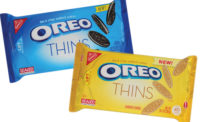Cookies have long been an easy treat. Consumers regularly search for comfort foods—and few edible pleasures can compare to sweet taste of a perfectly baked cookie. And while the classics continue to see strong sales, cookie bakers continue to expand their ranges to accommodate more emerging industry trends, effectively broadening appeal.
Overview | Bread | Tortillas | Sweet Goods | Snack Cakes | Pizza | Desserts | Cookies | Buns & Rolls | Bars | Breakfast Products
Market data
According to data from IRI, Chicago for the 52 weeks ending April 19, 2020, the cookie category was up 5.1 percent, with total sales of $9.3 billion. Most of the top 10 cookie companies in the industry saw gains for the year, with particularly notable growth for category leader Mondelēz International, up 7.0 percent to $3.6 billion in sales for the year; Pepperidge Farm, up 9.3 percent to $467.5 million; and Bimbo Bakeries USA, up 12.7 percent to $149.7 million. Better-for-you cookie producer Lenny & Larry’s Cookies also had a strong year, up 8.0 percent to $118.8 million.
The Mondelēz International/Nabisco brand Oreo continues to show enduring market strength. The standard line was up 15.7 percent to $845.5 million, while Oreo Double Stuf grew 10.5 percent to $342.0 million. The company’s breakfast cookie line belVita also had a strong year, up 12.4 percent to $421.0 million. Its Nabisco Nutter Butter line grew 11.6 percent to $144.9 million.
Other top-performing brands for the year include the top cookie variety from Pepperidge Farm, Milano, up 12.8 percent to $181.9 million, and Tate’s Bake Shop, up 24.0 percent to $103.2 million.
The refrigerated cookie/brownie dough segment grew 9.3 percent to $571.8 million. General Mills saw strong sales for its Pillsbury dough products, up 20.6 percent to $274.5 million. Clean-label, vegan cookie dough brand Sweet Loren’s also tracked very well for the year, up 52.8 percent to $17.7 million.
Ben & Jerry’s, a subsidiary of Unilever, took the frozen cookie dough category by storm over the past year with its ready-to-eat “Snackable Dough” line, catapulting to the top spot, with $12.8 million in sales through the 52 weeks ending April 19, 2020, per IRI. Companies offering traditional ready-to-bake frozen cookie dough also fared well. Private label offerings grew 24.5 percent to $1.7 million, and Gregory’s Foods saw its retail frozen cookie dough business grow by 14.3 percent to $1.3 million.
Frozen cookies also had a good year, with the category growing 18.0 percent to $12.9 million. Private label leads the way, up 1.7 percent to $4.2 million. This is an expanding category, with three new companies entering the market over the past year: French macaron specialist Sublime Desserts, with first-year sales of $2.2 million; Conagra Brands and Duncan Hines, with sales of $2.0 million; and Casa del Gelato, with sales of $581,407.
Looking back
“According to IRI numbers for 2019, the cookie category was the third largest subcategory within the bakery segment and had sales of $9.0 billion dollars, which grew by 3 percent versus prior year,” says Ricardo Rodriguez, marketing manager, confectionary and bakery, Ingredion Incorporated, Westchester, IL. “The three percent growth with the size of the category is decent growth.”
Gluten-free cookies grew in sales versus the prior year by 8 percent and has been steadily growing over the past few years, says Rodriguez. So gluten-free will continue to be important to the category, he suggests.
Rodriguez also notes that, based on new product launches, health and wellness and the “free-from” movement was important to the category over the last two years. Referencing data from Innova Market Insights, he says GMO-free positioning had a CAGR of 20 percent, and gluten-free had a CAGR of 15 percent. “Others, like no additives/preservatives, no HFCS, and high source of protein and fiber, continued to grow, as well,” he adds.
Ashley Dawkins, vice president, marketing, Sheila G's Brownie Brittle, West Palm Beach, FL, says that she has observed more “leaner labels”—no artificial ingredients, shorter ingredient deck overall—suggesting that such criteria have become the standard expectation from consumers when purchasing sweet snacks.
Dawkins also notes that some shoppers are looking for more from their cookies. “Added functionality—whether that means keto, antioxidants, reduced sugar, probiotics, added protein, etc.—continues to be what consumers are looking for when choosing products,” she says.
“The biggest trend we’ve noted to date has been the increase in plant-based, vegan varieties,” says Kevin Joseph, CMO, THINSTERS, Montclair, NJ. “In lieu of the lengthy list of ingredients that consumers are used to seeing within the cookie category, they now expect a shorter ingredient list, with natural, vegan ingredients in the same flavor profiles they know and crave.”
Vegan is getting particular attention. “In ingredient trends, specifically, we’ve seen the popularity of oat milk skyrocketing,” says Joseph. “Oat milk caters to vegan, dairy-free, and even general health food consumers.”
Michael Graf, director, Schubert Consulting, Crailsheim, Germany, says many manufacturers in the cookie market now focus on high-speed production. “In recent years, a change happened. Many have started to focus on single sizes.” He notes that product flavors and availability in different market channels has started to grow.
Philipp Ehrenfried, COO, Schubert Packaging Automation, Toronto, says customers are focusing on packaging a smaller amount of cookies in a flowpack instead of selling bigger trays filled with cookies. “Consumers prefer packaging formats that they can take along with them for snacks to go,” he says. “Another thing that has become very important for our customers is quality control—with scanners—and to retrieve quality data via open platform communications to control their quality. An ideal solution are single-source solutions, like our Flowmodul, that can be seamlessly integrated in an entire pick-and-place packaging system with integrated scanners.”
Looking forward
Joseph says shoppers will continue to seek new flavor profiles throughout the year. “For this reason, THINSTERS offers seasonal varieties that bring excitement to our line, such as our Meyer Lemon flavor that we offer in the summertime, and our Pumpkin Spice flavor that we offer in the fall.”
Plant-based, dairy-free, non-GMO, and better-for-you claims will remain at the front of consumers’ minds, suggests Joseph. To that end, THINSTERS is launching an Oat Milk Chocolate Chip cookie this summer, using a proprietary oat milk as the primary ingredient. “The formula uses our own, handcrafted oat milk that acts as a sweetener. This cookie variety inherently has less sugar, all while being plant-based, gluten-free, dairy-free, and non-GMO.”
Rodriguez notes that plant-based protein claims in new product launches for the bakery segment overall had a CAGR of 38 percent from 2015-2019. “When combined with consumers’ desire for better-for-you products that have added nutrition, I believe we will see more growth in plant-based protein claims in the cookie category this coming year.”
Another emerging area that Rodriguez believes will grow is sugar reduction. “Ingredion has been conducting proprietary consumer research into consumers’ perception of ingredients for over a decade. In the most-recent study, we looked at what ingredients consumers want to get less of in their diet in 2019 vs. 2009, and sugar was at the top of the list and had growth—in terms of avoidance—by 32 percent,” he notes. “In the same study, we asked consumers what specific items they check for most often when reading a label, and again, sugar was No. 1. On top of this, if you add the new labeling guidelines that call out ‘added sugars,’ you can understand why reducing sugar will be an important trend in the coming year.”
When looking to boost the protein levels of a cookie, there are many ways to do it effectively, says Rodriguez. “For instance, you can add pulse-based flours, which will have a higher level of protein and fiber than traditional flours. On top of that, you can add pulse protein concentrates, or a pea isolate, to help achieve specific protein goals in way that won’t compromise the taste and texture of the product.”
Today, if bakers want to reduce the sugar content in cookies without sacrificing taste and texture, they can look to solutions like natural high-potency sweeteners from stevia like reb A, M, and D, or stevia systems, suggests Rodriguez. Other options include low-sugar corn and tapioca syrups. Also, rare sugars like allulose won’t count as part of total and added sugars and is 70 percent as sweet as sugar, he notes.
While keto diets are contributing to a desire for reduced sugar, the trend is larger than one popular specialty diet. “Even though the keto diet may be a trend, I fully believe that consumers are going to be seeking out products with reduced sugar overall for the long-term future,” says Dawkins. “New products on the market that are able to deliver the low-sugar claim, but not compromise taste, are the products I believe will have staying power with consumers.”
Brownie Brittle KETO & Brownie Brittle PROTEIN were just launched to meet this need, says Dawkins. “Brownie Brittle KETO was developed to answer the consumer demand for thin, crispy, sweet snacks that fit within the keto guidelines. Our keto product has a clean ingredient deck, full chocolate brownie flavor, and no weird aftertaste. Brownie Brittle PROTEIN uses plant-based protein to deliver 18 grams of protein per 3.25-oz bag. It has the same great taste of the Original Brownie Brittle, now with the added functionality of plant based protein.”
In terms of equipment, a 2020 trend might be lower volumes, but more flexibility, which can translate to running different products on the same packaging line, says Giorgio Calorio, sales account manager, Schubert North America LLC, Charlotte, NC. “New products can keep, or help to increase, the attention of customers. Production lines will have to be ready and available to respond successfully to these scenarios. Of course, some existing and well-known brands/products will still have quite massive volumes, but probably reduced.”
Calorio says that in bakery, we have to change our way of thinking—not only in packaging. “The technology is partially already available, but unfortunately too many people in this business are extremely focused on volumes rather than on flexibility, IoT, and AI. Some customers of ours are already focusing on buying lines for 3,000–4,000 pcs/min maximum instead of 10,000–15,000 pcs/min on the medium-long run while expecting more flexibility.”
Overview | Bread | Tortillas | Sweet Goods | Snack Cakes | Pizza | Desserts | Cookies | Buns & Rolls | Bars | Breakfast Products












